Nagapattinam – The last citadel of Buddhism in South India

Mid 19th century in Tamil Nadu, an ancient dilapidated tower stood majestically in the Nagapattinam seashore as a lone reminder of a forgone heritage. Known locally then as the ‘puduveli gopuram’ none knew what it was. The British rulers decided to dismantle it and build a school in its place. They also chopped off an ancient tree as part of the construction. To the surprise of all, the laborers found a brick chamber below the roots of the tree. There were five exquisitely carved ancient Buddha statues well preserved inside that chamber! This triggered a major archeological investigation by the British and by 1930s, around 350 bronze statues of Buddhas and Bodhisattvas were discovered from various parts of Nagapattinam. From the inscriptions that were uncovered by then, it also became evident that the dilapidated tower was part of the famed Mahayana Buddhist Monastery, Chudamani Vihara, constructed in 1006 CE during the reign of Rajaraja Chola I. The statues were hidden below a tree, probably to protect them during a raid by some hostile forces.
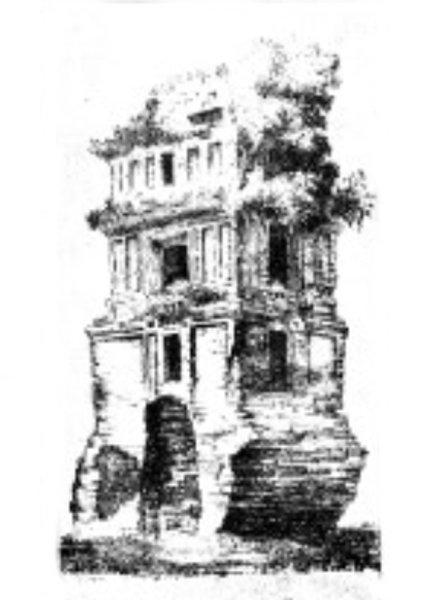
Nagapattinam was interestingly both one of the first and the last centers of Buddhism in South India. Even now, there are places such as Sangamangalam, Buddhamangalam, Putthakkudy, etc around Nagapattinam, as a reminiscence of its Buddhist past. It was a major port city of the medieval Cholas with maritime connections to many east asian countries. The nearby port, Poompuhar, was the capital of the Chola kingdom of the Sangam Age. Stone and clay statues of the Buddha from the 2nd Century CE and the remains of monasteries are found in Poompuhar (Poompuhar – A Long Lost City from the Sangam Age). Pallava king Narasimhavarman II (7th to 8th century) also built a vihara at Nagapattinam. The Chudamani Vihara in Nagapattinam was constructed by the Srivijayan king Sri Mara Vijayattungavarman of the Sailendra dynasty with the help of Rajaraja Chola I. According to the archeologists, the bronze statues found from Nagapattinam (that we cover in this post) belong to various periods between 9th to 17th Century CE (AD). Around Nagapattinam, there are also many ancient stone statues of the Buddha (8th to 10th Century CE) in places such as Pushpavanam, Peruncheri, Thirunellivakaval, Buddhamangalam etc. From this can be inferred that Mahayana Buddhism thrived in Nagapattinam till 17th Century CE. .
Out of the 350 bronze pieces, the British authorities kept 80 pieces in the Chennai Museum, and they distributed the rest to many other Museums in India and abroad. A 1954 publication by T. N. Ramachandran (Ref 1) has many monochrome images of the statues of the Buddha and Bodhisattvas, and the Stupas from the collection of the 80 in the Chennai Museum. These include many rare sculptures such as that of Shadakshari Lokesvara (Four-armed form associated with the mantra Om Mani Padme Hung).
However, when we visited the Chennai Museum during last October, we could see only 2 statues — a standing Avalokitesvara and a standing Maitreya. During this March, we revisited the Museum and this time with the help of the Museum authorities we could see a larger collection in the Buddhist and Jain Bronze Gallery that otherwise remained locked. There were about 20 Buddhist sculptures in that Gallery, of which only less than 10 belonged to the Nagapattinam collection. (The rest were from Sellur, that we will be covering in another post.) According to the curator, the rest of the statues are in the reserve as they are supposedly too small to display. Unfortunately, the online gallery of the museum also do not show most of these statues. A 2015 publication by Dr. Kannan, the then Director of Museums, (Ref 2) has color photos of some of the Buddhist bronzes that are currently not in display. However, this book also mentions that a few statues, particularly a gold-plated statue of Maitreya and two Buddha statues, were stolen from the Museum in 1982. It is also possible that some other statues are exchanged with other Museums around the country. It will be good if authorities can do a complete stock verification and establish a directory with the current location of all Nagapattinam and Sellur bronzes.
Statues still Present in Nagapattinam
For the statues still present in various parts of Nagapattinam District, see A Majestic Vestige of Buddhism in Pushpavanam and Presence of Buddhism in Buddhamangalam and Peruncheri.
Nagapattinam Buddha and Bodhisattva Statues in Various Museums
In this section, in addition to the statues that we could directly see in Chennai Museum, we have also listed some of the other Nagapattinam bronzes which are supposed to be in that Museum. For that we rely on the photos from Ref 1, Ref 2 and the photos available on the online gallery of the museum. The purpose is to touch upon a representative set of Nagapattinam bronzes.
1 – Buddha
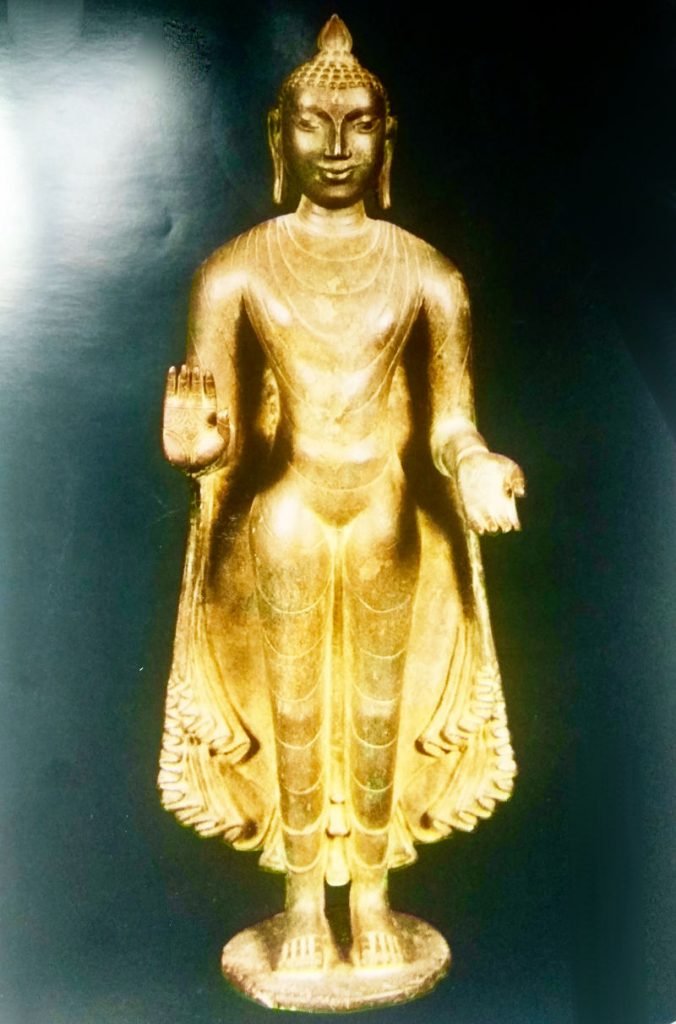
This Buddha statue (1ft in height) was obtained from Velippalayam in Nagapattinam, Tamil Nadu, and then kept in Chennai Museum. This Buddha’s features seem very South Indian. His urna is embossed in silver. The palm marks and urna mark of the Buddha statues of Nagapattinam are done in many different shapes. According to archeologists, this is from the 12th Century CE.
2 – Buddha
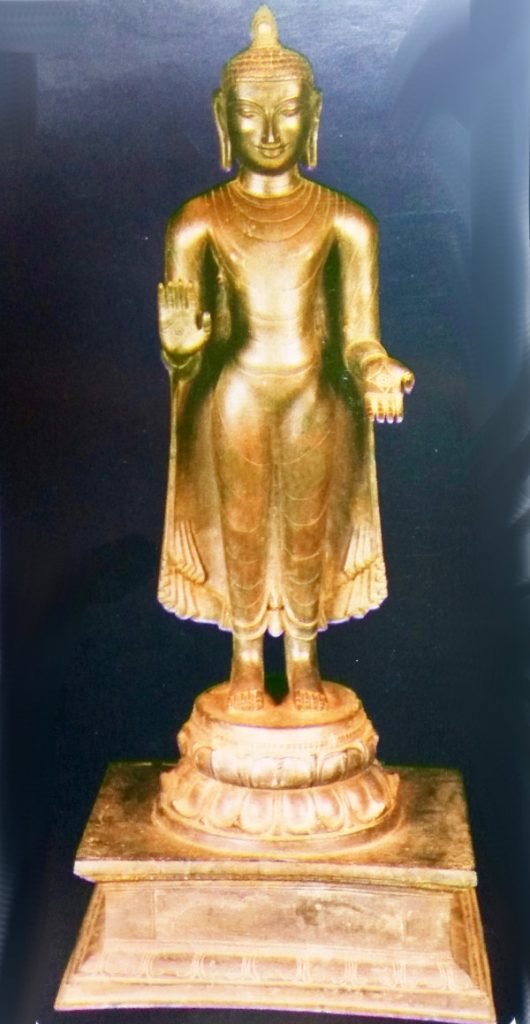
This Buddha statue (1’8” in height) was obtained from Velippalayam in Nagapattinam, Tamil Nadu, and then kept in Chennai Museum. According to archeologists, this is from the 12th Century CE.
3 – Buddha
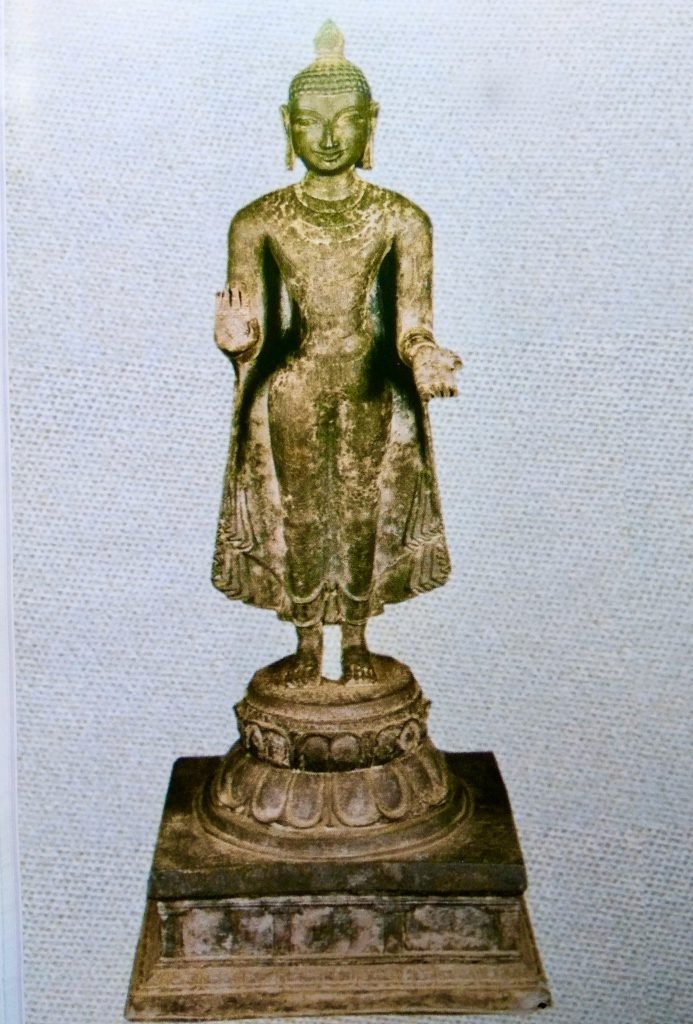
This Buddha statue (1ft in height) was obtained from Velippalayam in Nagapattinam, Tamil Nadu, and then kept in Chennai Museum. According to archeologists, this is from the 12th Century CE.
4 – Buddha

This Buddha statue (1’7” in height) was obtained from Velippalayam in Nagapattinam, Tamil Nadu, and then kept in Chennai Museum. According to archeologists, this is from the 14th Century CE. The square pedestal below his lotus seat has his name inscribed as ‘Nāyakar’. It means, the leader, another epithet of the Buddha.
5 – Buddha
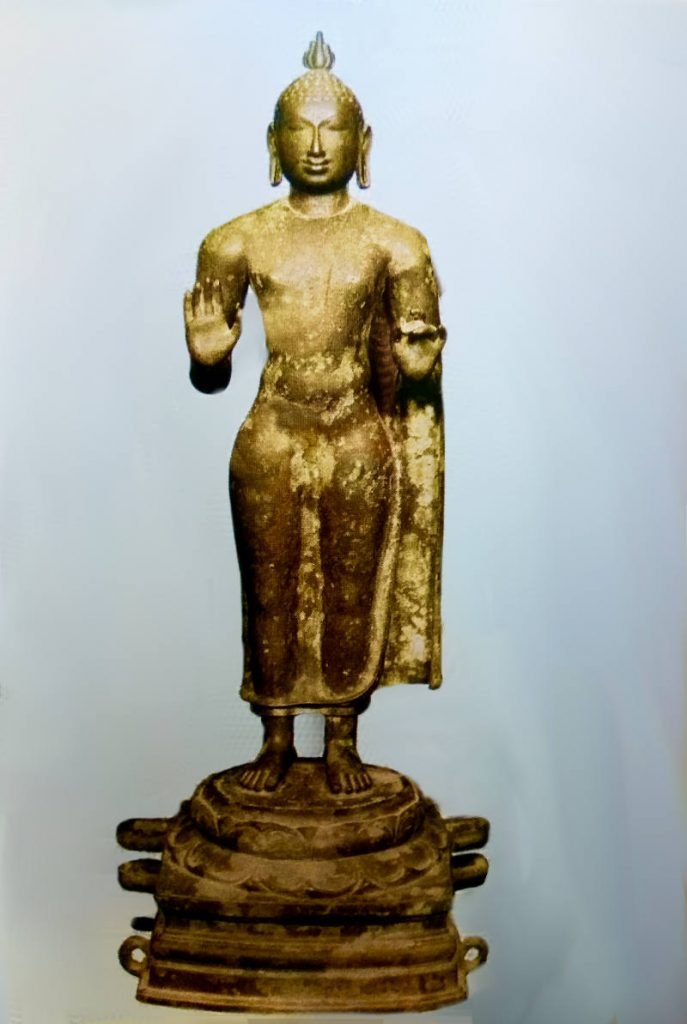
This bronze statue of Buddha (2’6” in height) stands on a padma-peetha (Lotus seat) over a bhadra-peetha (square seat). This was obtained from Nanayakkara street in Nagapattinam, Tamil Nadu. A rare aspect of this statue is that the left hand of the Buddha is in karana mudra (gesture of warding off obstacles and negativities). The rings on the square base indicates that perhaps this statue was used for the annual procession through the city (nagara-pradakshina / bum-khor). According to archeologists, this is from the 10th Century CE.
6 – Buddha

This beautifully finished statue of the Buddha was obtained from Nanayakkara Street in Nagapattinam, Tamil Nadu. It is 2’6” in height. The details include a cushion behind, two vyalis on the two sides of the seat, two Nagarajas holding chamaras (fly-whisk) on either side of the Buddha. There is a beautiful ornate Bodhi tree carving at the top with a chatra (umbrella) above the Buddha. According to archeologists, this is from the 11th Century CE. This is currently preserved in the Chennai Museum.
7 – Maitreya
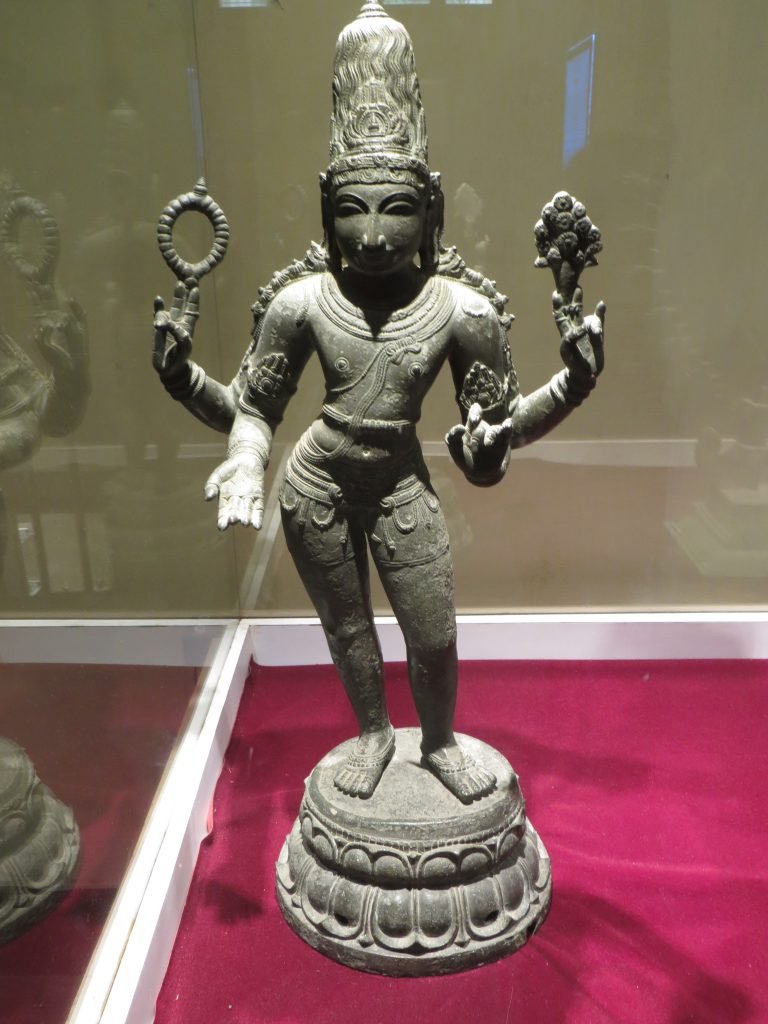
This bronze statue of Maitreya Bodhisattva (2.5 ft) from Nanayakkara street, Nagapattinam, Tamil Nadu is now kept in the Chennai Museum. He can be identified as Maitreya because he is adorned with a miniature stupa at his crown. In this statue, Maitreya has a crown of matted hair (jata makuta). His upper hands hold mala (rosary) and a bunch of naga flowers, and the lower hands show varada (gesture of giving) and karana (gesture of warding off negativity) mudras respectively. The holes on the base and the size indicates that perhaps this statue was used for the annual procession through the city (nagara pradakshina, bum-khor). According to the archeologists it is from the 14th Century CE.
8 – Maitreya

This beautiful statue of Maitreya (1ft 4 inches) was lost from Chennai Museum. This is a copper-gilt (gold platted copper) statue. This was originally from Melayur in Nagapattinam, Tamil Nadu. The stupa on his crown indicates that he is Maiteya. According to archeologists, this is from the 9th Century CE. Ref 2 officially states that this statue was stolen and lost from Chennai Museum in 1982, along with two other Buddha statues.
9 – Maitreya

This bronze statue of a Bodhisattva (10 inches) is from Velippalayam, Nagapattinam, Tamil Nadu. He holds a bunch of flowers which resembles Maitreya’s Naga pushpas. The stupa on the kirita makuta is not clear. Archeologists identified this as Maitreya. They date this to be belonging to the Vijayanagara period of sculptural styling, but not later than 1500CE. There is an inscription on the base which says, “Periya Pillai Nayanar” meaning Nayanar (Bodhisattva) made by Peria Pillai. According to Ref 2 (from 2015), this statue was in the Chennai Museum. However, it is not in display now.
10 – Maitreya
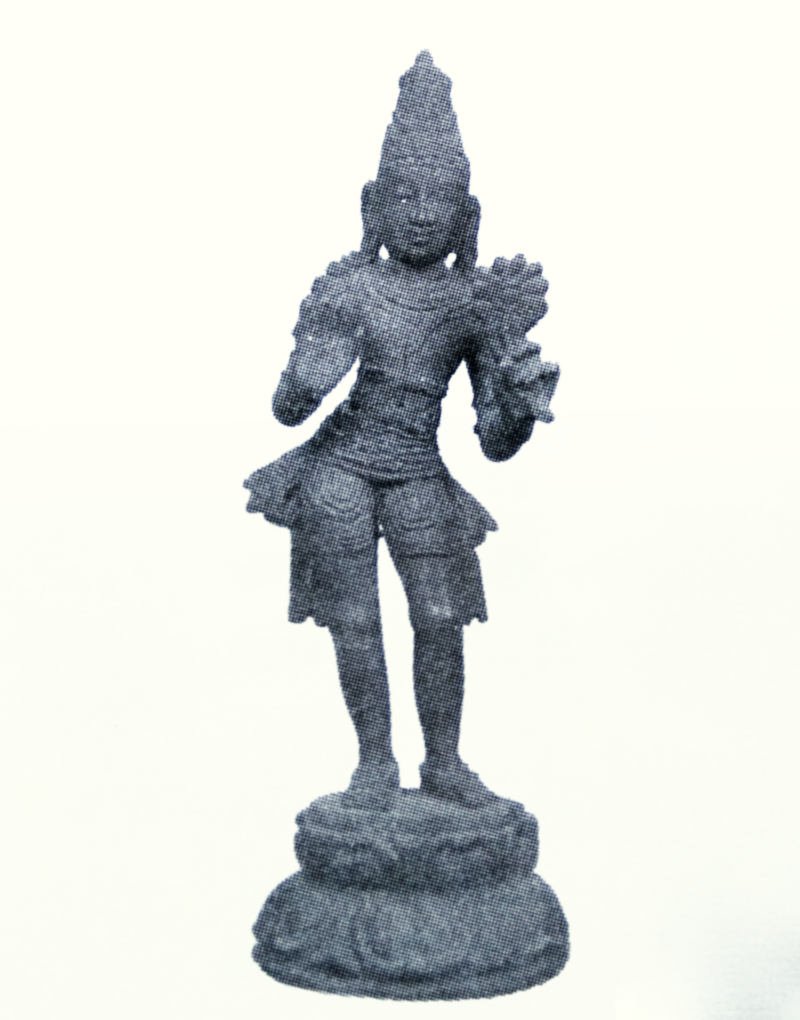
This bronze statue of a Bodhisattva (6 inches) is from Velippalayalm in Nagapattinam, Tamil Nadu. His left hand holds a flower which is closer to a Naga flower than lotus. And, one of the marks on his kirita makuta (crown) is probably a stupa. From this, he may be identified as Maitreya. According to Ref 1 (from 1954), this statue was in the Chennai Museum, however it is not in display now. According to the archeologists it is from the 13th Century CE.
11 – Maitreya

This bronze statue of a Bodhisattva (4 inches) is from Velippalayalm in Nagapattinam, Tamil Nadu. His left hand holds a flower which is closer to a Naga flower than lotus. And, one of the marks on his kirita makuta (crown) is probably a stupa. From this, he may be identified as Maitreya. According to Ref 1 (from 1954), this statue was in the Chennai Museum, however it is not in display now.
12 – Avalokitesvara

This bronze statue of Avalokitesvara (3.5ft in height) was from the 17th Century CE (according to the archeologists). This was obtained from Velippalayam in Nagapattinam, Tamil Nadu. This indicates that Nagapattinam was a thriving centre of Buddhism even as late as the 17th Century. In this statue, Avalokitesvara has Buddha Amitabha at his crown. He holds a bunch of nine lotuses on his upper left hand, and a mala (rosary) on his upper right hand. The other two hands are with varada and abhaya mudras. The bhadrasana base has four holes indicating that perhaps this statue was used for the annual procession through the city (nagara-pradakshina / bum-khor).
13 – Avalokitesvara

It is rare to find Avalokitesvara’s Shadakshari form in South India, though it is very popular in Tibet. Shadakshari Lokesvara is the form associated with the popular mantra, ‘Om Mani Padme Hung’. In this statue (4 inches) from Velippalayam in Nagapattinam, Tamil Nadu, he has Buddha Amitabha at his crown of matted hair (jatamakuta). He has four hands with emblems such as padma (red lotus), mala (rosary) and mani (wishfulfilling jewel). According to the archeologists, this is from the 11th Century CE.
This very important piece with a great significance to historic presence of Vajrayana Buddhism in South India is unfortunately not traceable now. According to Ref 1 (published in 1954), this statue was in the Chennai Museum. However it is not in display now. There is also no reference about it either in the museum web gallery or in Ref 2 (published in 2015).
14 – Avalokitesvara

It is rare to find Avalokitesvara’s Shadakshari form in South India, though it is very popular in Tibet. Shadakshari Lokesvara is the form associated with the popular mantra, ‘Om Mani Padme Hung’. In this statue (4 inches) from Velippalayam in Nagapattinam, Tamil Nadu, he has Buddha Amitabha at his crown of matted hair (jatamakuta). He has four hands with emblems such as padma (red lotus), mala (rosary) and mani (wishfulfilling jewel). The mala is broken even in the 1954 photo of this statue. According to the archeologists, this is from the 11th Century CE.
This very important piece with a great significance to historic presence of Vajrayana Buddhism in South India is unfortunately not traceable now. According to Ref 1 (published in 1954), this statue was in the Chennai Museum. However it is not in display now. There is also no reference about it either in the museum web gallery or in Ref 2 (published in 2015).
15 – Avalokitesvara
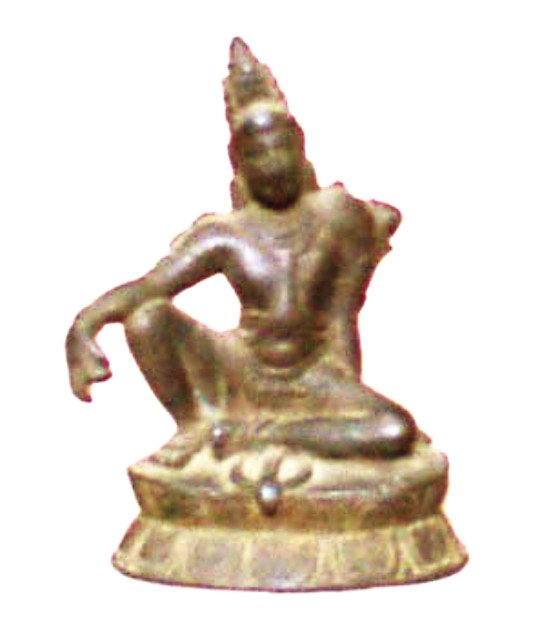
This miniature bronze statue of Avalokitesvara / Lokesvara (3 inches) is from Velippalayalm in Nagapattinam, Tamil Nadu. His left hand holds a lotus flower, and he is seated in rajaleela-asana (the posture of royal ease). This statue is not in display now. According to the archeologists it is from the 11th Century CE.
16 – Avalokitesvara
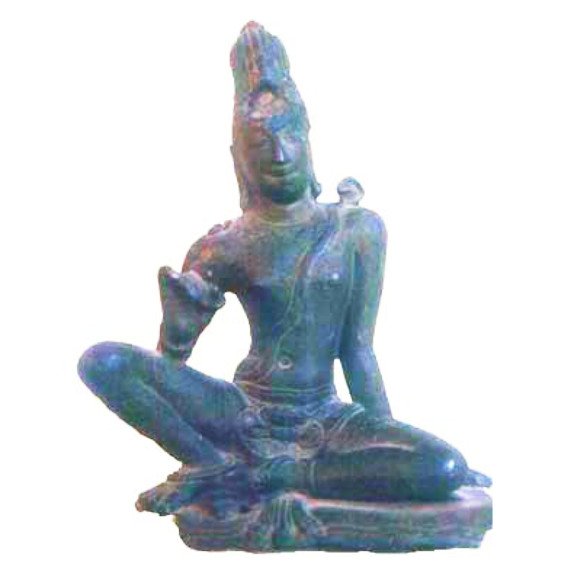
This miniature bronze statue of Avalokitesvara / Lokesvara (4 inches) is from Velippalayalm in Nagapattinam, Tamil Nadu. This form is without hand emblems such as lotus flower. His right hand is kept in karana mudra (gesture of warding off negativity). He is seated in rajaleela-asana (the posture of royal ease). This statue is not in display now. According to the archeologists it is from the 9th Century CE.
17 – Avalokitesvara
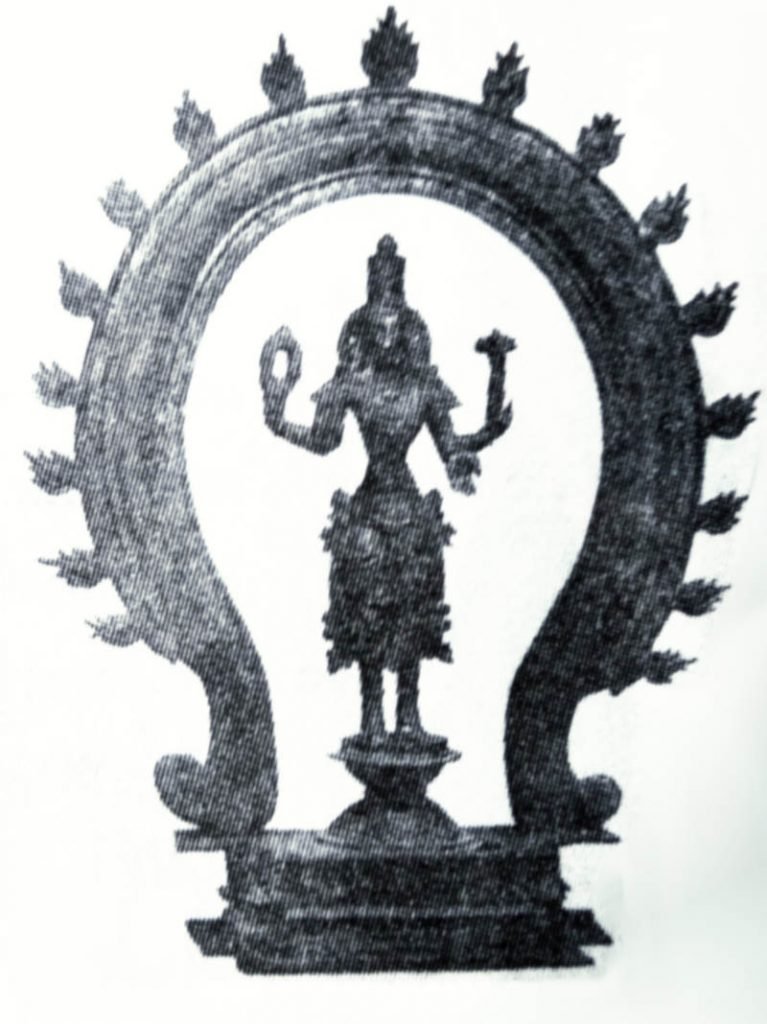
This bronze statue of Avalokitesvara (2’2” in height) was from the 17th Century CE (according to the archeologists). This was obtained from Velippalayam in Nagapattinam, Tamil Nadu. This indicates that Nagapattinam was a thriving centre of Buddhism even as late as the 17th Century. In this statue, Avalokitesvara has Buddha Amitabha at his crown. He holds a bunch of five lotuses on his left hand, and a mala (rosary) on his right hand. According to Ref 1 (from 1954), this statue was in the Chennai Museum, however it is not in display now.
18 – Tara
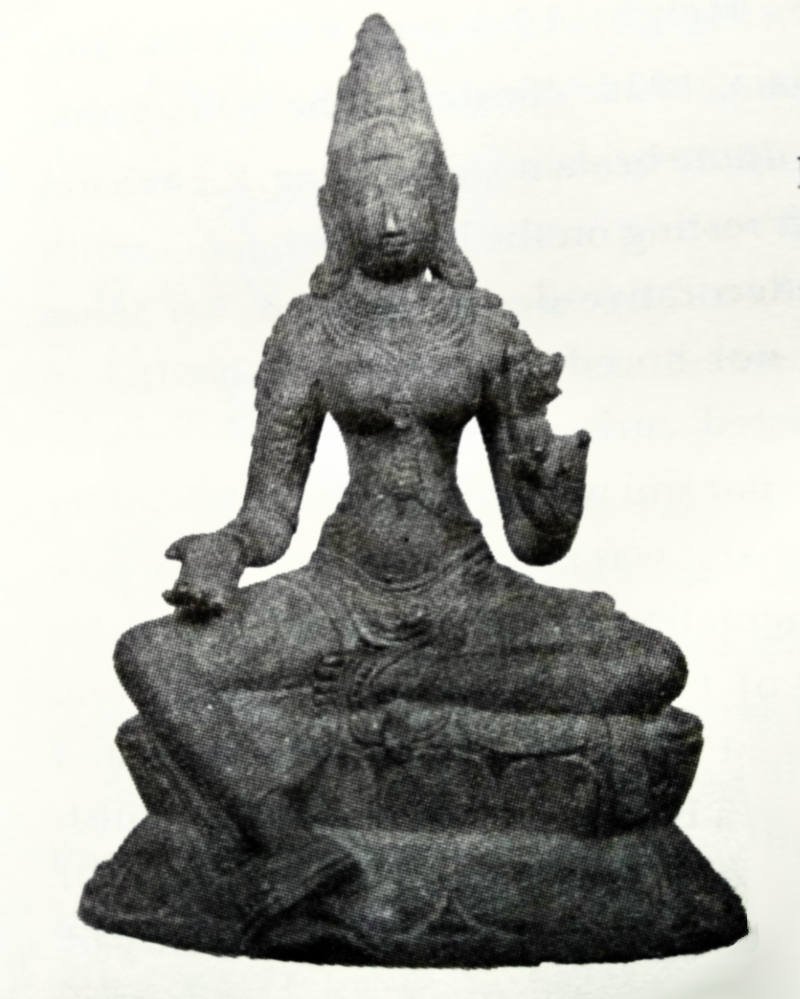
This miniature statue of Tara (5 inches) was obtained from Velippalayam in Nagapttinam, Tamil Nadu. This form matches with her popular form in North India and Tibet. She sits in lalitha-asana. In her left hand kept in karana mudra, she holds an utpala flower (blue lotus). The right hand is in varada mudra. According to the archeologists, this is from the 13th Century CE. According to Ref 1 (from 1954), this statue was in the Chennai Museum, however it is not in display now.
19 – Tara
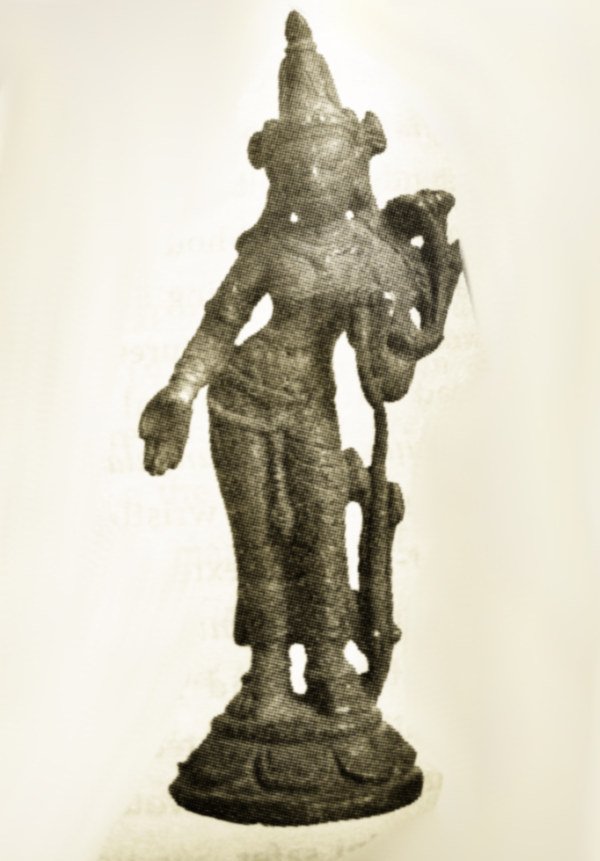
This miniature statue of standing Tara (4 inches) was also obtained from Velippalayam in Nagapattinam, Tamil Nadu. In her left hand kept in karana mudra, she holds an utpala flower (blue lotus). The right hand is in varada mudra. According to the archeologists, this is from the 11th Century CE. According to Ref 1 (from 1954), this statue was in the Chennai Museum, however it is not in display now.
20 – Jambhala
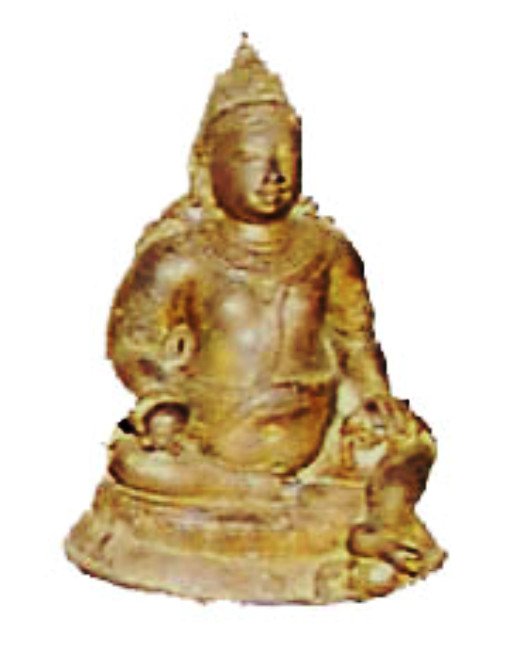
This bronze statue of Jambhala (4 inches) is from Velippalayam in Nagapattinam, Tamil Nadu. He holds a citron fruit in his right hand and a mongoose in the left. Jambhala’s extended left foot kept over a bag of riches. This photo is from the Chennai Museum’s website gallery. However the statue is not in display now. According to the archeologists it is from the 11th Century CE.
21 – Jambhala and Vasudhara

This bronze statue of Jambhala and Vasudhara (3 inches in height) is from Velippalayam, Nagapattinam, Tamil Nadu. A dharmachakra carving is there in the lotus seat. Jambhala holds a citron in his right hand and a mongoose in the left. Vasudhara’s right hand holds a small bowl with gems. In her left hand she holds a sheaf of corn (broken) representing abundant harvest. Jambhala’s extended right foot and Vasudhara’s extended left foot rests on bags of riches. This photo is from the Chennai Museum website gallery. However the statue is not in display now. According to the archeologists it is from the 11th Century CE.
22 – Stupa
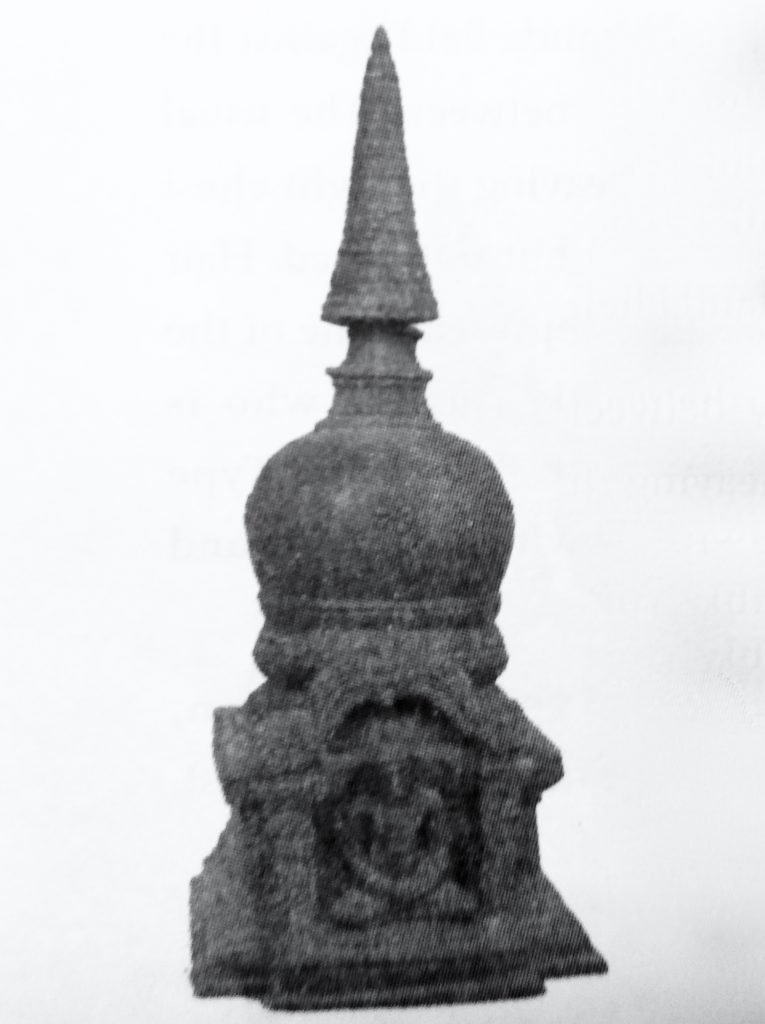
This bronze Stupa (10 inches) from Nanayakkara street, Nagapattinam, Tamil Nadu is now kept in the Chennai Museum. According to the archeologists it is from the 11th Century CE. On the front and back sides are carved Buddha figures in dhyana and bhumisparsa mudras respectively.
23 – Bhikshu

This miniature bronze statue of a Bhikshu (3 inches) is from Velippalayam, Nagapattinam, Tamil Nadu. His hands are in anjali mudra with a mala held between palms. According to Ref 1 (from 1954), this statue was in the Chennai Museum. However, it is not in display now.
24 – Bhikshus

These miniature bronze statues of Bhikshus (6 inches) are from Velippalayam, Nagapattinam, Tamil Nadu. According to Ref 1 (from 1954), these statues were in the Chennai Museum. However, they are not in display now.
25 – Bhikshuni

This miniature bronze statue of a Bhikshuni (4.5 inches) is from Velippalayam in Nagapattinam, Tamil Nadu. Her left hand holds a scripture and right hand is in vitarka (teaching) mudra. According to Ref 1, this statue was in the Chennai Museum, however it is not in display now.
Museums with Nagapattinam Buddha Statues
Some of the Museums and collections worldwide where statues from Nagapattinam are present are listed below.
- Chennai Museum, (Buddhist bronzes gallery
- Indian Museum, Kolkata
- Napier Museum, Thiruvananthapuram
- CSMVS (Chhatrapati Shivaji Maharaja Vastu Sangralaya) Museum Mumbai, (Photo courtesy – The Heritage Lab )
- Chandigarh Museum
- Art Institute of Chicago
- Metropolitan Museum of Art, New York
- Asia Society Museum, New York
- Victoria and Albert (V&A) Museum, London
- Norton Simon Museum, Pasadena, California
- Los Angeles County Museum of Art (LACMA)
- The British Museum
- Marcel Nies Collection
We have dealt with some of the Nagapattinam statues from Chennai Museum in the previous section. Below are some of the statues from Nagapattinam preserved in other Museums inside and outside India.
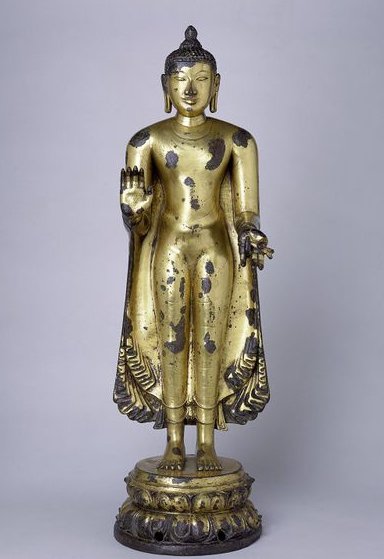

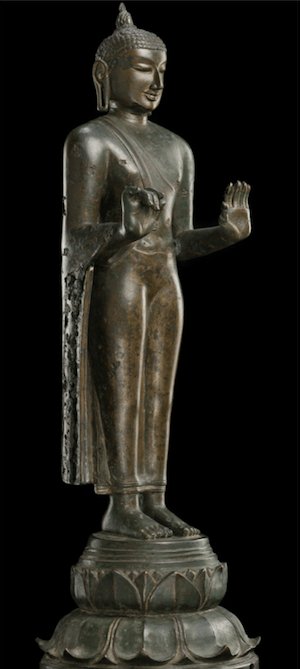
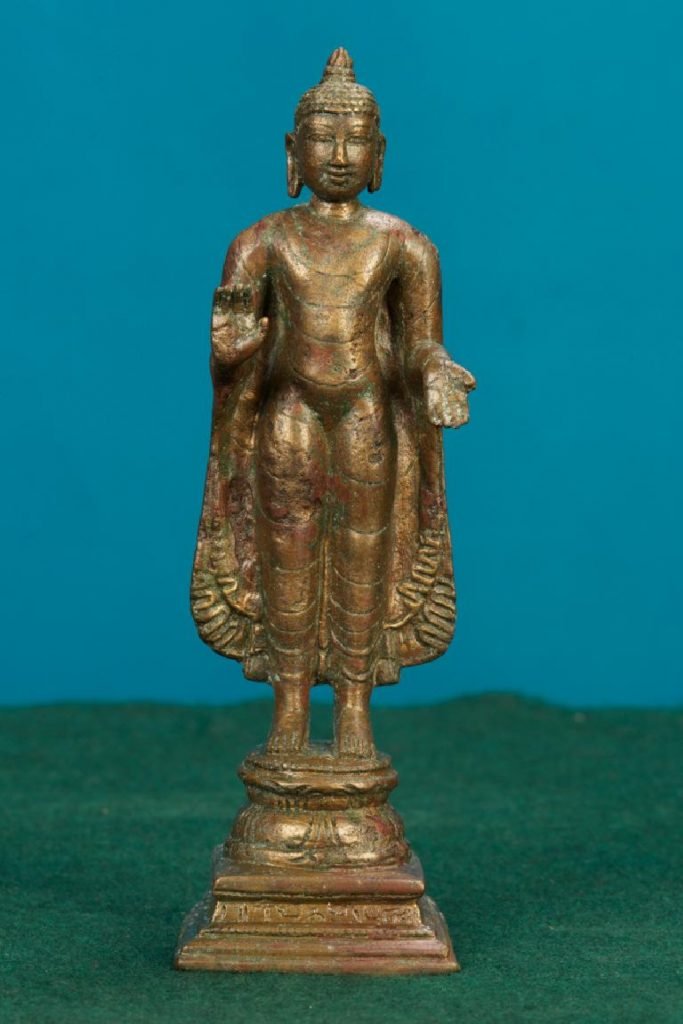

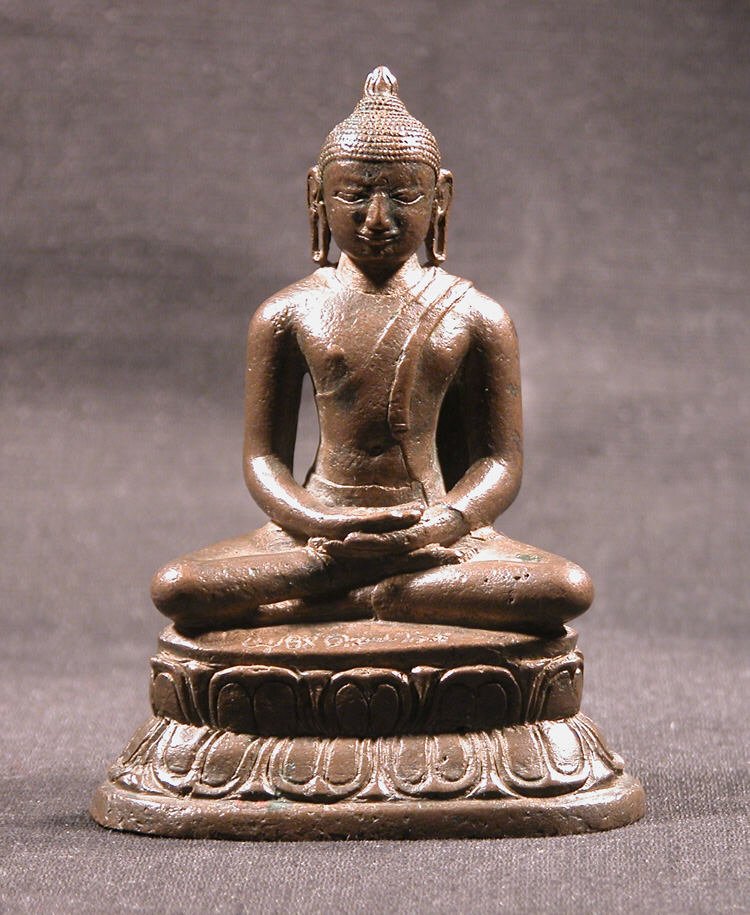
References
- Ref 1 – The Nagapattinam and Other Buddhist Bronzes in the Chennai Museum by T.N.Ramachandran. First Ed 1954, Revised Ed 2005.
- Ref 2 – Manual on the Bronzes In the Government Museum, Chennai By Dr. R. Kannan, First Ed 2003, Revised Ed 2015.
Other articles on Buddhism in Nagapattinam
Poompuhar – A Long Lost City from the Sangam Age
Nagapattinam – The last citadel of Buddhism in South India
Ancient Buddhist statues unearthed in Sellur, Tamil Nadu
Buddhism in Thiruvarur, Tamil Nadu
A Majestic Vestige of Buddhism in Pushpavanam
Buddha Statues of Buddhamangalam and Peruncheri.
- Putheri (Buddheri) – The Southern most Stupa of Ancient India - January 19, 2023
- History of Buddhism in Kerala - January 12, 2022
- Buddhism in Kallakurichi, Tamil Nadu - March 4, 2021


Salutations..
I gone through your detailed work on Nagapattinam Vihar.
Really I appreciate your write-up.
May I be provided with the copy of the same.
Thank you,
Great Work ! Well Done !
I thought the Indonesian Vihara was lost for ever (Chudamani Vihara) but you brought the story and pictures to life. An important part of Chola and Sri Vijaya relations that later soured
Thank you !
Great work, it will give awareness to all tamil people.
A great work , valuable information. namo Buddhaya
Thank you for this write up. Very interesting and thanks for the beautiful pictures of the various Buddhist statues. I am planning a trip to Nagappatinam side this Dec 2022. Can you recommend any museums in the area that would have any statues?
Most of the statues from Nagapattinam are currently in Chennai Museum. There is a separate building there hosting the bronze statues. However, you can see a few very old miniature stone statues at Marine Archeological Museum, Poompuhar. (See https://www.wayofbodhi.org/ancient-buddhist-places-of-tamilnadu-poompuhar). Also, some large sized stone statues can still be seen right at the sites of their discovery. For example, see,
https://www.wayofbodhi.org/buddhism-in-pushpavanam-nagapttinam-buddha-statue and
https://www.wayofbodhi.org/buddha-statues-of-buddhamangalam-and-peruncheri
A MARVELLOUS AND WELL RESEARCHED DETAILS OF BUDDHISM THAT WAS FLOURISHING I THIS PART OF ANCIENT THAMIZHAGAM Kudos!
Is there any specific information available on the Golden Buddha statue stolen by Thirumankai Alvar?
The story about the Golden Buddha statue stolen and melted by Thirumangai Alvar is coming from the hagiographies of the 12 Alvars. The detailed episode can be found in a compilation cum translation of such hagiographies by Alkondavilli Govindacharya in his book “The Holy Lives of the Azhvars
Or The Dravida Saints”.
The story goes like this. Thirumangai Alvar was a robber before becoming a devotee. Later on in his life he started doing the renovation of the Vishnu temple of Srirangam. Short of funds, he decided to rob a Buddha Temple in Nagapattinam of its Golden Buddha idol. Successfully stealing the Buddha idol, he melted it and selling that gold, made enough funds to finish his construction work.